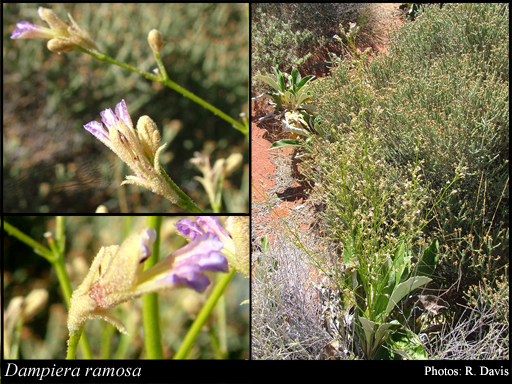- Reference
- Telopea 3:213 (1988)
- Conservation Code
- Not threatened
- Naturalised Status
- Native to Western Australia
- Name Status
- Current
Erect, tufted perennial, herb, 0.15-0.4 m high. Fl. purple-blue, Sep to Oct. Red or grey sand. Sand dunes.







Scientific Description
Stems unribbed. Leaves flat, 90-300 mm long, 20-75 mm wide, Indumentum absent (leaves glabrous); margins entire. Bracteoles present, 2-3.5 mm long, glabrous. Pedicel pedicellate, Pedicel length the pedicels 0.5-2 mm long, glabrous. Calyx lobes present, Calyx length 3-4 mm long, hairy, with dense, dendritic hairs. Corolla blue, 9-11 mm long, auriculate, not spurred, hairy on the outside, with dense, dendritic hairs, glabrous on the inside; central lobes 4-8 mm long, with wings; outer lobes 5.5-9 mm long, wings present on both sides, 0.2-0.3 mm wide. Anthers connate. Ovary inferior, not gibbose; style 4-5.5 mm long, glabrous; indusium single, glabrous; ovules one or two. Flowers in September and October. Occurs in the Murchison (MUR), Central Ranges (CR) and Little Sandy Desert(LSD) IBRA Region(s), of the Eremaean (E) Botanical Province.
Distribution
- IBRA Regions
- Central Ranges, Gibson Desert, Great Victoria Desert, Little Sandy Desert, Murchison, Nullarbor.
- IBRA Subregions
- Carlisle, Central, Eastern Murchison, Lateritic Plain, Mann-Musgrave Block, Shield, Trainor.
- Local Government Areas (LGAs)
- Laverton, Leonora, Menzies, Ngaanyatjarraku, Wiluna.